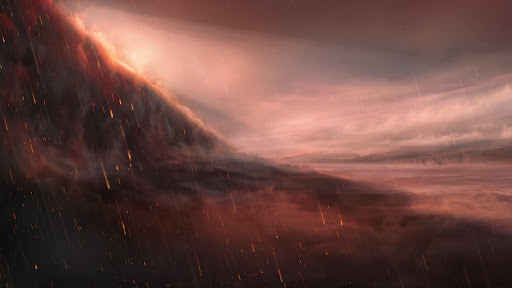Imagine a world unlike any you've ever seen. A scorching gas giant where temperatures reach over 4,350 degrees Fahrenheit (2,400 degrees Celsius). Here, iron rains down from the skies, not as a solid metal, but as superheated vapor. This is the bizarre and fascinating world of WASP-76b.
A Fiery Giant Close to its Star
WASP-76b is a distant exoplanet, located roughly 640 light-years away in the constellation Pisces. Discovered in 2013, this monster of a planet falls under the classification of a "hot Jupiter." These gas giants share similarities with our own Jupiter, but with a dramatic twist: they orbit their stars incredibly close. In WASP-76b's case, it circles its host star in less than two Earth days, this planet revolves around its parent yellow star at a distance of 30 million miles. If we compare it with Jupiter, Jupiter is 484 million miles away from the sun. Even this planet revolves closer than Mercury, the nearest planet to our sun. The distance between Mercury and Sun is also 36 million miles. which means it's constantly bombarded with intense stellar radiation.
This proximity is the key to WASP-76b's mind-blowing weather. The relentless heat blasts the planet, vaporizing metals like iron in the atmosphere. As the planet rotates and the day side cools slightly compared to the scorching permanent day side, the iron vapor condenses and falls back down as rain.
The Debate Over Iron Rain
The idea of iron rain on WASP-76b is certainly captivating, but there's a bit of a scientific twist. Initial studies in 2020 suggested the presence of iron in the atmosphere, hinting at this dramatic weather phenomenon. However, there were challenges. Distortions from a companion star and limitations in data collection created some uncertainty.
By 2 2021, scientists were re-evaluating the data. While the presence of iron in the atmosphere seems confirmed, it's still unclear if it condenses into rain. Current models suggest the possibility of dense cloud formations containing iron, but large-scale iron rain on the night side remains under debate.
More Than Just Iron Rain: A World of Extremes
WASP-76b is a treasure trove for astronomers studying extreme exoplanets. Here are some additional key points about this fascinating world:
- Size and Mass: WASP-76b is a heavyweight, boasting a mass roughly twice that of Jupiter.
- Day-Night Temperature Difference: The permanent day side sizzles at over 2,400 degrees Celsius, while the cooler night side might reach a comparatively comfortable 1,400 degrees Celsius.
- Atmospheric Composition: Studies suggest the presence of various molecules like water vapor and titanium oxide, alongside the iron.
Future Studies: Unveiling the Secrets of WASP-76b
WASP-76b is a prime target for upcoming telescopes like the James Webb Space Telescope (JWST). With its advanced capabilities, JWST promises to provide a deeper look into the planet's atmosphere, potentially confirming or refuting the iron rain theory. Additionally, studying the composition and circulation patterns of the atmosphere can offer valuable insights into the formation and evolution of such extreme exoplanets.
WASP-76b is a testament to the diversity of worlds in our universe. With continued exploration, this scorching gas giant might just reveal even more secrets about its fiery skies and the exotic weather patterns that reign supreme.



Comments
Post a Comment